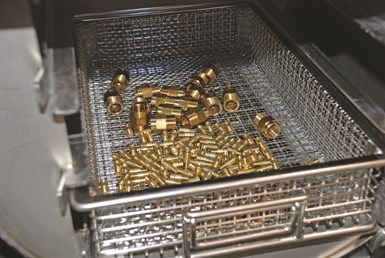Aqueous Processes Offer Safe, Effective Cleaning
Environmental concerns and safety issues are pushing manufacturers to replace chlorinated solvents with water in cleaning processes. Understanding aqueous cleaning processes is critical to knowing whether or not to make the switch.
Edited by Angela Osborne
Increasing environmental concerns and safety issues associated with chlorinated solvents is leading many manufacturers to consider aqueous cleaning processes. Ozone depletion, worker safety considerations and updated regulations from the Environmental Protection Agency (EPA) and Occupational Safety and Health Administration (OSHA) regarding air, water and soil contamination are all concerns of companies using chlorinated solvent cleaners.

Hubbard-Hall offers the following information to help precision machine shops understand ultrasonic and mechanical cleaning, which are aqueous processes that can replace chlorinated solvent cleaning.
Ultrasonic Cleaning
Ultrasonic cleaning builds upon the concept of soak cleaning with the additional use of high-frequency sound or ultrasonic waves. A combination of chemistry and this form of energy effectively removes a variety of soils including but not limited to oils, greases, buffing and polishing compounds, paraffins and waxes, abrasives, rouges, metallic chips, fragments and shavings.
An ultrasonic generator, coupled with a transducer unit, changes the signal to mechanical energy which, in turn, produces a cavitation action that scrubs parts clean. In the working solution, cavitation intensity increases as the temperature of the cleaning solution increases. This usually holds up to a solution temperature of 160°F (71°C). Beyond this temperature, cavitation steadily decreases.
The careful racking or fixturing of parts is one of the keys to ultrasonic cleaning success. . This maximizes exposure to the desired levels of ultrasonic energy, thereby enhancing the effectiveness of the cleaner chemistry. Design and fixturing of parts promotes good solution drainage, prevents air entrapment and allows for penetration of ultrasonic energy. Similarly, there is an optimal alignment of transducer to parts, so routine maintenance of the transducer is crucial to performance.
There are a variety of criterion to consider when choosing the appropriate cleaning process. Aluminum, brass, white metal and zinc are the metals most commonly cleaned ultrasonically. It’s important to choose the chemistry which is compatible with the substrate being cleaned. Ultrasonic cleaning solutions normally provide formulations in the pH range of 8 to 13. Cleaning nonferrous or more sensitive metals may also require inhibitors in the cleaner concentrate. Ultrasonic cleaning may be the first step in surface preparation or it may precede a soak cleaner.
If cleaning the parts is the sole requirement, proper drying is essential. Mechanical dryers such as spin units, hot air knives, or centrifugal types are most commonly used for this purpose.
Mechanical Cleaning
Mechanical cleaning can make quick work of soil removal. It is an economical yet effective method for bulk cleaning stamped and mechanically formed parts. It is particularly effective when used with paint, powder coat and phosphate lines.
This type of cleaning combines chemical and mechanical energy. Its comparatively lower temperature requirement — ranging from 120 to 150°F (49-66°C) — reduces heating costs as it lowers energy demands. Sprays and other forms of agitation during the cycle provide significant mechanical force, improving the overall removal of soils.
Cleaner blends are low foaming and blended with powerful solvents (SARA Title III exempt types), dispersants and water conditioners (to prevent the plugging of spray nozzles). The pH of cleaners range from near neutral to 14. Blends are available for all sensitive metals, nonferrous and ferrous types.
The appropriate mechanical action for the job at hand is critical to cleaning success.
In spray cleaning, the PSI application is important for part coverage and the optimization of soil displacement.
In wash machines, agitation trays or baskets of parts are placed in sealed compartments. Up/down, rotational and/or side-to-side action occurs. For optimal performance, racking of parts or placement in bulk tubs must be considered in parts configuration or design.
To extend cleaner bath service life, waste treatment can be simplified. Also, recirculation tanks can be continually skimmed to remove oily and grease soils.
Using a combination of the right chemistry, equipment and cleaning process can help manufacturers achieve the necessary part cleanliness standards while meeting increasing regulatory requirements.
RELATED CONTENT
-
Heat’s Impact on Parts Cleaning
Thermal dynamics is important for assisting in the cleaning of a part. Adding heat or energy influences the cleaning process through its impact on chemistry, the water within the washer and its effect on drying.
-
VIDEO: Vapor Degreasing Process Uses TCE Replacement to Eliminate Hazardous Waste
A solid relationship with a solvent manufacturer has aided Electro-Spec Inc. with the implementation of a trichloroethylene replacement material in its vacuum degreasing unit to clean a customer’s micromachined parts more efficiently.
-
Get to Know Cleanliness Standards
With a small amount of practice, it is possible to understand the underlying motivation of a cleaning standard and to figure out the specific aspects of the specification that are applicable to the customer.



